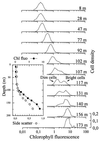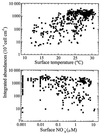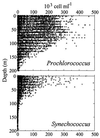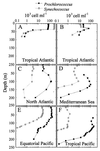Prochlorococcus, a marine photosynthetic prokaryote of global significance
- PMID: 10066832
- PMCID: PMC98958
- DOI: 10.1128/MMBR.63.1.106-127.1999
Prochlorococcus, a marine photosynthetic prokaryote of global significance
Abstract
The minute photosynthetic prokaryote Prochlorococcus, which was discovered about 10 years ago, has proven exceptional from several standpoints. Its tiny size (0.5 to 0.7 microm in diameter) makes it the smallest known photosynthetic organism. Its ubiquity within the 40 degrees S to 40 degrees N latitudinal band of oceans and its occurrence at high density from the surface down to depths of 200 m make it presumably the most abundant photosynthetic organism on Earth. Prochlorococcus typically divides once a day in the subsurface layer of oligotrophic areas, where it dominates the photosynthetic biomass. It also possesses a remarkable pigment complement which includes divinyl derivatives of chlorophyll a (Chl a) and Chl b, the so-called Chl a2 and Chl b2, and, in some strains, small amounts of a new type of phycoerythrin. Phylogenetically, Prochlorococcus has also proven fascinating. Recent studies suggest that it evolved from an ancestral cyanobacterium by reducing its cell and genome sizes and by recruiting a protein originally synthesized under conditions of iron depletion to build a reduced antenna system as a replacement for large phycobilisomes. Environmental constraints clearly played a predominant role in Prochlorococcus evolution. Its tiny size is an advantage for its adaptation to nutrient-deprived environments. Furthermore, genetically distinct ecotypes, with different antenna systems and ecophysiological characteristics, are present at depth and in surface waters. This vertical species variation has allowed Prochlorococcus to adapt to the natural light gradient occurring in the upper layer of oceans. The present review critically assesses the basic knowledge acquired about Prochlorococcus both in the ocean and in the laboratory.
Figures











References
-
- Andersen R A, Bidigare R R, Keller M D, Latasa M. A comparison of HPLC pigment signatures and electron microscopic observations for oligotrophic waters of the North Atlantic and Pacific Oceans. Deep-Sea Res II. 1996;43:517–537.
-
- Andersen R A, Morton S L, Sexton J P. CCMP-Provasoli-Guillard National Center for culture of marine phytoplankton. J Phycol. 1997;33:1–75.
-
- Barlow R G, Cummings D G, Gibb S W. Improved resolution of mono- and divinyl chlorophylls a and b and zeaxanthin and lutein in phytoplankton extracts using reverse phase C-8 HPLC. Mar Ecol Prog Ser. 1997;161:303–307.
-
- Barlow R G, Mantoura R F C, Cummings D G, Fileman T W. Pigment chemotaxonomic distributions of phytoplankton during summer in the western Mediterranean. Deep-Sea Res II. 1997;44:833–850.
-
- Bazzaz M B, Brereton R G. 4-Vinyl-4-desetyl chlorophyll a: a new naturally occurring chlorophyll. FEBS Lett. 1982;138:104–108.
Publication types
MeSH terms
Substances
LinkOut - more resources
Full Text Sources

